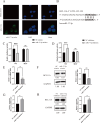Upregulation of miR-17-3p is associated with HbF in patients with β-thalassemia and induces γ-globin expression by targeting BCL11A
- PMID: 40448206
- PMCID: PMC12124070
- DOI: 10.1186/s13023-025-03806-0
Upregulation of miR-17-3p is associated with HbF in patients with β-thalassemia and induces γ-globin expression by targeting BCL11A
Abstract
Background: Large number of microRNAs (miRNAs) have been found to be dysregulated in β-thalassemia, but their roles in β-thalassemia are poorly reported. This study aims to investigate the clinical significance of miR-17-3p in β-thalassemia, and to elucidate its regulatory effect on erythropoiesis and γ-globin expression.
Methods: We collected peripheral blood samples from 17 patients with β-thalassemia (including intermedia and major subtypes) and 17 healthy controls, and the expression levels of miR-17-3p, BCL11 transcription factor A (BCL11A) and γ-globin were detected by qRT-PCR, and their correlations were analyzed. The regulation of miR-17-3p on BCL11A was evaluated in K562 cells by bioinformatics, luciferase reporter gene assay, fluorescence in situ hybridization and Western blotting. Furthermore, the effects on miR-17-3p overexpression and knockdown on erythropoiesis including cell proliferation, cell cycle, cell apoptosis, and erythroid differentiation of K562 cells were assessed by CCK-8, flow cytometry and benzidine blue staining.
Results: The expression of miR-17-3p was upregulated in patients with β-thalassemia, and was positively correlated with fetal hemoglobin (HbF) levels. BCL11A expression was reduced in β-thalassemia patients, and was negatively correlated with miR-17-3p and γ-globin expression. BCL11A was identified as a target gene of miR-17-3p, and was negatively regulated by miR-17-3p. Furthermore, miR-17-3p mediated the upregulation of γ-globin expression in K562 cells through BCL11A. In addition, neither overexpression nor knockdown of miR-17-3p appeared to affect cell proliferation, cell cycle, cell apoptosis or erythroid differentiation of K562 cells in vitro.
Conclusion: The upregulated miR-17-3p is associated with HbF in patients with β-thalassemia. Although miR-17-3p does not affect erythropoiesis, it promotes γ-globin expression by targeting BCL11A, suggesting that miR-17-3p may be a promising miRNA for the treatment of β-thalassemia.
Keywords: BCL11A; Erythropoiesis; HbF; miR-17-3p; β-thalassemia.
© 2025. The Author(s).
Conflict of interest statement
Declarations. Ethics approval: This study was proved by the Ethics Review Committee of Fujian Maternity and Child Health Hospital (approval no. 073, 2019). Written informed consent to participate was obtained from all of the parents of the participants in the study and the study was conducted in accordance with the Declaration of Helsinki. Consent for publication: Written informed consent was obtained from the patient for publication of this case report and any accompanying images. Competing interests: The authors declare that they have no conflicts of interest.
Figures







Similar articles
-
The role of miR-129-5p in regulating γ-globin expression and erythropoiesis in β-thalassemia.Hum Mol Genet. 2025 Feb 8;34(4):291-303. doi: 10.1093/hmg/ddae180. Hum Mol Genet. 2025. PMID: 39657657
-
MicroRNA-92a-3p-mediated inhibition of BCL11A upregulates γ-globin expression and inhibits oxidative stress and apoptosis in erythroid precursor cells.Hematology. 2022 Dec;27(1):1152-1162. doi: 10.1080/16078454.2022.2128258. Hematology. 2022. PMID: 36178486
-
miR-30a regulates γ-globin expression in erythoid precursors of intermedia thalassemia through targeting BCL11A.Mol Biol Rep. 2020 May;47(5):3909-3918. doi: 10.1007/s11033-020-05483-7. Epub 2020 May 13. Mol Biol Rep. 2020. PMID: 32406020
-
Transcriptional Repressor BCL11A in Erythroid Cells.Adv Exp Med Biol. 2024;1459:199-215. doi: 10.1007/978-3-031-62731-6_9. Adv Exp Med Biol. 2024. PMID: 39017845 Review.
-
Activating transcription factor 4 in erythroid development and -thalassemia: a powerful regulator with therapeutic potential.Ann Hematol. 2024 Aug;103(8):2659-2670. doi: 10.1007/s00277-023-05508-8. Epub 2023 Oct 31. Ann Hematol. 2024. PMID: 37906269 Review.
References
MeSH terms
Substances
Grants and funding
- no.2023ZQNZD009/the Major Scientific Research Program for Young and Middle-aged Health Professionals of Fujian Province
- no. 81970170/the National Natural Science Foundation of China
- no.2021Y9173, 2021Y9174,2023Y9364/Joint Funds for the innovation of science and Technology, Fujian province
- no.2023J011217/Fujian Provincial Natural Science Foundation of China
- no.2021Y2012/Innovation Platform Project of Science and Technology, Fujian provinc
LinkOut - more resources
Full Text Sources

